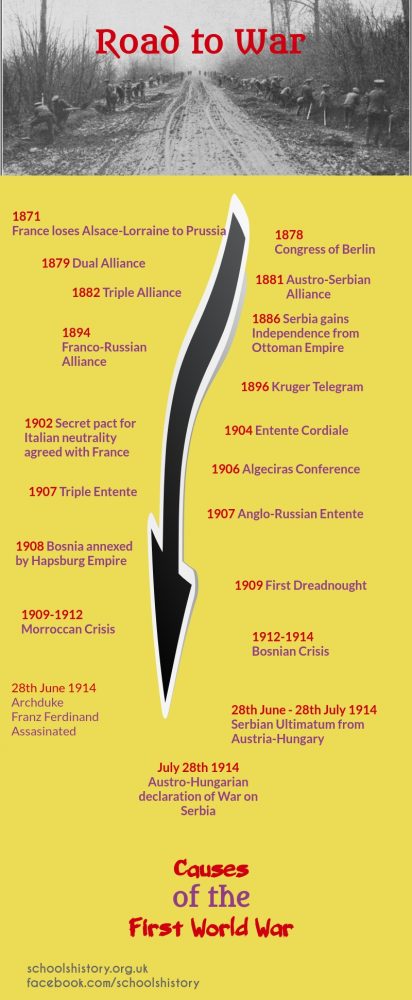Timeline: The Causes of the Great War
A Timeline of the Causes of the First World War. This timeline covers most of the events leading up to the outbreak of the First World War in 1914. It covers the period 1870 until the Declaration of War on Serbia by the Austro-Hungarian Empire on 28th July, 1914. The events leading to the First World War are a mixture of militaristic developments, alliance building, issues relating to imperialism and assertions of Nationalism.

The First World War broke out between Europe’s major powers in the summer of 1914. The chain of events leading to the declarations of war and those in the immediate aftermath dragged multiple other nations into a conflict that became global in scale.
The decades leading up to the war saw numerous minor conflicts ad disputes. A common starting point, the one we have adopted, is to trace developments from the Franco-Prussian War through to the outbreak of the World War.
Following the Franco-Prussian War a number of trends emerged in international politics. The French were wary of the unifying German state. To counter this, they wanted the security of allies. This is seen in the French alliance with Russia, the neutrality agreement that they secretly agreed with the Italians, the Entente Cordial and then the Triple Entente.
This was met with fear of encirclement by the Germans. Consequently, they in turn looked to develop alliance systems. They had close relationships with the Austro-Hungarian Empire and subsequently added the Italians to their alliance network to form the Triple Alliance.
These Industrial powers also sought to maintain or expand their colonies and empires. In a world in which Empires were connected via shipping lanes, a strong navy was required. The British had enjoyed naval domination of the seas, particularly around Europe, since the end of the Napoleonic Wars. They saw the development of naval bases and investment in military vessels as a threat. To counter this, they introduced the Dreadnought. This triggered a naval race with Germany that did nothing to ease tensions between the two.
The disintegration of the Ottoman Empire led to disputes. The Balkans region became a vacuum of power in the east of Europe. This vacuum was one that several major powers wanted to fill. Russia and Austria-Hungary both vied for influence in the region. The newly independent states fought to remain exactly that. The clash of newfound nationalism and old style expansionism provided the spark for the war.
Links
[products limit=”4″ columns=”4″ category=”first-world-war” cat_operator=”AND”]
Causes of the First World War – Timeline of Causes – Forgotten Causes – Assassination of Franz Ferdinand – The Schlieffen Plan – Historiography of the Causes of the First World War
Outbreak of War (Public reaction in Britain) – The British Expeditionary Force in 1914
Trench Warfare – Simulation: Would you make a good officer in the trenches? – British contribution to the Western Front
Battles of the First World War – First Battle of the Marne – The Gallipoli Campaign – Battle of Verdun – Battle of Jutland – Brusilov Offensive – Battle of the Somme – Battle of Passchendaele – The Spring Offensive – Battle of Amiens – Victory on the Western Front?
The Home Front – Revision exercise – Changing role of Women – Propaganda – Censorship – Conscientious Objectors – Rationing and Recruitment
Personalities – Douglas Haig and the Somme – Charles Gass – Billy Bishop – Ludendorff – The Bradford Pals – Black History and the First World War
Technology and New Weapons – British Tanks – Machine Guns
Medicine in the First World War
Other wars:
The Norman Conquest – The Wars of the Roses – The British and English Civil Wars – The Second World War – Vietnam War – Cold War
Famous Battles:
Battle of Hastings – Battle of Towton – Battle of Bosworth – D Day
Related Content:
The British Empire – The Treaty of Versailles – Impact of the War on Germany – Primary History – History Teachers Resources

